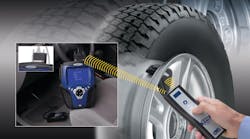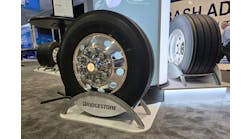There are so many topics coming into play within the automotive industry that you would think every technician would be concentrating all their attention on. Topics like telematics, greenhouse gas reduction technologies and OBD hacking. Yet even with all of these game changers in front of us, a major buzzword still seems to be Tire Pressure Monitoring Systems (TPMS).
TPMS has been mandated by the Transportation Recall Enhancement, Accountability and Documentation (TREAD) Act since 2007 and has actually been in existence since the 1980s. Its purpose is just what its name implies. So how does it work? Sensors inside the tires monitor the pressure and tell an electronic control module (ECM). If a tire pressure is low, a warning light comes on. Seems simple, right? Yet an idea so simple, is a lot more intricate than one would think.
Q: What are the biggest issues a technician may experience with TPMS systems?
A: There are three TPMS issues that a technician will face if he works with tires: relearns, sensor failures, and sensor programming.
1) Relearns: You come across these when you do a tire rotation. Many manufacturers have each tire sensor position “learned” so when a sensor fails, the ECM knows which tire to alert you of. Every time you rotate the tires, you need to do the manufacturer specific relearn procedures in order for the vehicle to learn the new position of the tires.
Many times, technicians who skip this procedure end up having it catch up to them in the long term. For example, let’s say the technician does the tire rotation. There is no TPMS light on, so he sends it on his way. Later down the road, on a busy day (because every technician knows these things only happen on your busiest day), the customer comes in stating their right front tire is low and would like the technician to put air in it.
Guess what that technician gets to do? Check every tire, wondering which one is low. If the customer is observant, he may even ask, “why are you adding air to the right rear tire when it says the right front is low?” Now the technician has to explain that he got lazy on that customer’s prized possession the last time they were in.
So remember this every time you do a tire rotation. The vehicle may need a TPMS relearn. But remember on the plus side, it’s okay to charge extra for it
2) Failures: TPMS failures are when you have an issue with the TPMS system. This can be a mechanical failure or an electrical failure. Many failures lead to sensor replacement. Replacing sensors leads to the next issue, sensor programming.
3) Sensor Programming: Just like getting a new ECM in a car requires programming, so do TPMS sensors.
According to TPMS experts., there are two main types of aftermarket replacement sensors for TPMS. One type comes blank and needs the vehicle protocol programmed onto it, while another type comes with all manufacturer protocols built into it, and your reset tool picks which protocol you want it to use. Therefore, it is important to know what your tool is capable of so that you know the type of sensor to order from your parts supplier when replacing sensors.
Q: What would I need to be service ready for TPMS?
A: To be fully TPMS capable, you need to start at your parts supplier. They need to have sensors readily available for delivery. You also need to be aware of the types of sensors they have. Are they blank and in need of a protocol programmed into it? Or do they have every protocol already programmed and need selecting? The answer to this is critical for the next step.
Remember how the old adage goes, “You gotta have the right tools to do the job.” Something we technicians have had beaten into our brains since day one.
You need to have the tools to diagnose, repair, and program the TPMS systems. Manufacturers for TPMS equipment include Bartec USA, ATEQ Corp. and Bosch OTC. From the ATEQ Corp. VT55 to Bartec's TPMS Mechanical Tool Kit to Bosch OTC's TPMS reset tool, these companies bring a wide variety of user-friendly, yet technologically advanced tools to the table, whether you are diagnosing faults, mechanically repairing sensor parts, or programming the sensors.
Q: Why is TPMS service advantageous in California?
A: On Sept. 1, 2010, the California Air Resources Board's Tire Pressure Regulation came into effect, declaring that all automotive service providers must set a vehicle’s tire pressure every time they touch a car, then record their findings on the invoice. The tire pressure gauge must also be accurate within 2 PSI above or below actual pressure.
This is a free rein to inspect tires and TPMS systems! Either way, you are going to have to approach tire pressure with the customer, so why not use it to your advantage? This is where customers will see that not only did you follow the law and record their set tire pressure, but you were also proactive enough to go above and beyond to let them know how to take care of their TPMS systems, even if everything checks out fine.
So as much as people try to avoid TPMS, its clearly here to stay. It’s as integral a part of our diagnostics as anything else. Therefore, with proper education and tooling, TPMS can be embraced instead of questioned and shunned.




